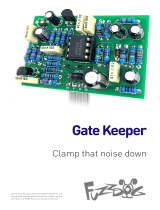Page is loading ...

Ultimatum Fuzz
The Ultimate experience in
vintage-style octave-up fuzz
Contents of this document are ©2015 Pedal Parts Ltd.
No reproduction permitted without the express written
permission of Pedal Parts Ltd. All rights reserved.

Before you dig in, ensure you download
and read the General Build Guide.
It contains all the information you need
for a successful outcome.
General
Build
Guide
Your first stop
for build info
Contents of this document are ©2023 Pedal Parts Ltd.
No reproduction permitted without the express written
permission of Pedal Parts Ltd. All rights reserved.

Schematic + BOM
R1 1M
R2 1K
R3 47K
R4 47K
R5 100K
R6 100K
R7 4K7
R8 100K
R9 4K7
R10 100K
R11 100K
R12 220R
R13 CLR (2K2)
R14 CLR (2K2)
R15 15K
R16 150K
R17 10K
R18 1K
R19 22K
R20 4K7
R21 470K
R22 47K
R23 1K5
R24 10K
R25 100K
C1 47n
C2 47n
C3 1n
C4 10u elec
C5 10u elec
C6 10u elec
C7 10u elec
C8 10u elec
C9 10u elec
C10 15n
C11 100n
C12 10u elec
C13 10u elec
C14 100u elec
C15 10p
C16 1n
D12 Germanium*
D34 LED
D56 Germanium*
D7 1N4001
Q14 2N3904
TONE 100KB
VOL 100KB
SUST 100KB
SW1 SPDT ONON
*The orientation of the diodes is
very important. ‘Normal’ diodes
will have the stripe indicating
the cathode, so should be
placed as indicated by the PCB
silkscreen. Russian diodes have
the anode indicated by the
stripe, so should be reversed.
If in doubt, ask.


Snap the small metal tag off the pots so they can be mounted flush in the box.
You should solder all other board-mounted components before you solder the pots.
Once they’re in place you’ll have no access to much of the board.
PCB Layout ©2015 Pedal Parts Ltd.

The back of your board should be looking lovely, just like this (except you haven’t attached the
ribbon cable yet - just imagine it isn’t there).
You’re ready to get the footswitch daughterboard set up. Let’s go...

When mounting the footswitches it’s a good idea to do it using the enclosure. Drop the footswitches
into their holes in the enclosure, but on the top face on the box (as above). Now place your
daughterboard onto the switches and get them nice and straight. Solder a single tag of each
footswitch into place, then take them out of the enclosure and check the positioning. You want the
tags as horizontal as possible for the best fit, and the switches should be flat against the PCB. If
they’re at all wonky, melt the solder joint and adjust. Once they’re looking good and you’re sure they
still sit in the enclosure holes ok, get the other tags soldered in too. Don’t forget to solder in the
current limiting resistors for your LEDs, but leave the LEDs out for now.

Now you need to join the two boards together. You have a nice 6-way ribbon cable, right? If not, just
run six lengths of wire between the two boards. The pads are clearly marked, just join like for like.
Now attach some decent lengths of wire to the rest of the offboard pads - your V and G connections
at the top of the board, and your jack connections on the daughterboard. Ignore those LEDS again -
they aren’t really there...

Now we take a break from the norm. Usually you’d do some testing before boxing up your circuit. In
this case there are only six connections to make offboard, and they’re the same connections you’d
have to make to test the circuit as to actually complete it, so let’s go ahead and make them neat.
NOW we get to place those LEDs too. Pull the LEDs through the board (long leg to round pad), and
bend the legs slightly so they don’t fall out. Get your jacks and DC socket in place and tightened.
Now drop your two circuit boards into place and tighten things up. Connect your jack and DC wires
(there’s a diagram on the next page if it needs to be clearer than the pic below). Of course, your DC
socket will be on the correct side of the enclosure. Oops!
You can now get your LEDs in place. Straighten the legs and push them down to locate into their
holes in the enclosure. Once seated, solder them in. Simple! No need for bezels.
WHY IS THERE AN EXTRA PAD FOR THE ‘OCTAVE’ FOOTSWITCH LED...?
You can use a bi-colour LED in there if you want, i.e. green for normal, red for octave.
Use a common-anode LED. We like to keep it simple around here though, so a standard LED is supplied.

Wiring
IN OUT
Couldn’t be much simpler. Six wires to connect as above.
This circuit is standard, Negative GND. Your power supply should be Tip Negative / Sleeve Positive.
That’s the same as your standard pedals (Boss etc), and you can safely daisy-chain your supply to
this pedal.

30mm
19mm
60mm
14mm
Drill sizes:
Pots 7mm
Jacks 10mm
Footswitch 12mm
DC Socket 8mm
Toggle switches 6mm
Drilling template
Hammond 1590BB - 91 x 116 x 31mm
Drill sizes listed are minimum.
It’s a good idea to add 1mm to anything mounted
on the PCB that’ll poke through the front of the
enclosure.
This template is a rough guide only. You should ensure correct marking of your
enclosure before drilling. You use this template at your own risk.
Pedal Parts Ltd can accept no responsibility for incorrect drilling of enclosures.
FuzzDog.co.uk
/












